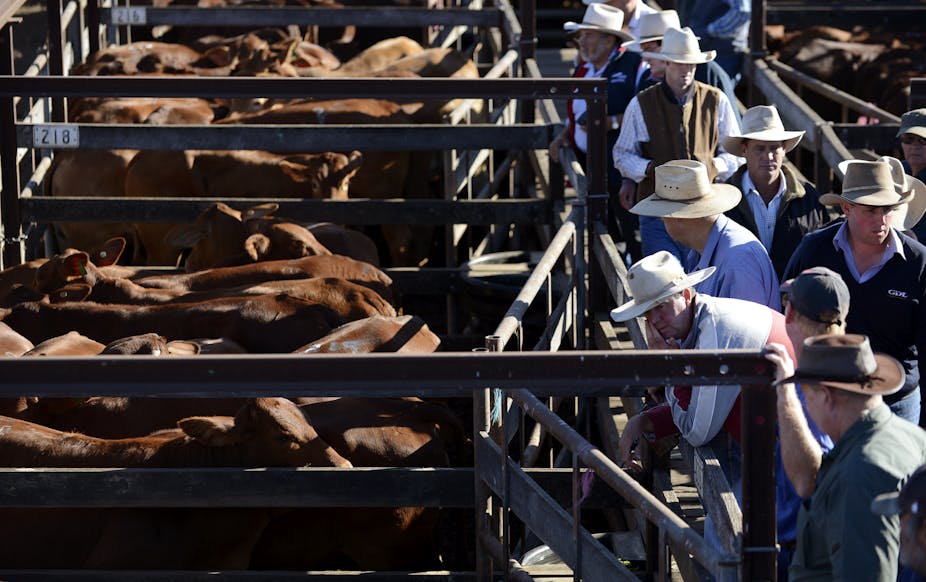In this ‘Economy in transition’ series, we explore the new economy facing Australia and the opportunities available to help the country shift from a minerals-led powerhouse, to a smart competitor in emerging global sectors. Today, we look at the sectors expected to lead Australia’s “pivot” from mining.
Iron ore has been Australia’s largest export, but as minerals prices plunge, Australia’s economy is under pressure to pivot away from mining and toward the next big boom.
With the exception of Rio Tinto and BHP, the whole Australian iron ore industry is now digging dirt for a loss. The fourth largest iron ore producer, Atlas Iron, will suspend its entire production by the end of this month.
Chinese demand for Australian minerals may be slowing but demand for Australian food and agricultural products is predicted to grow.
Minerals down, food up
Chinese economic growth is slowing and so is its hitherto astonishing rate of infrastructure and building development.
The World Steel Association recently predicted little growth for steel demand globally in the next two years. The Chinese steel industry is also expected to maintain its production capacity at about 800 million tonnes annually due to its declining domestic consumption and pressure from the environmental protection. Australia’s thermal coal exports have suffered a similar fate as China tightens rules on air pollution and plans to cut coal consumption by 80 million tonnes by 2017.
However, China has substantially increased its imports of Australian food produce. In 2012-13, China was the second largest export destination for Australian food, accounting for 10% of the total Australian food export by value and trebling it from 2002-03. With the rise of Chinese middle class (a group estimated to number around 250 million), the demand for high quality and value-added Australian food, such as red meats, infant formula milk, seafood, wine, dairy products is and will be strong in the future. It is estimated that China has become the largest export destination of Australian food since 2014.
Australian agriculture sector exports about two-thirds of its food by value annually. However, Australia is expected to only contribute about 3% of the value of global food exports to 2050.
While the debate rages on whether Australia is or is not the “food bowl of Asia”, there’s no question Australia’s reputation as a clean and safe “brand” positions it well as a key supplier of premium food to China.
However, significant investment in the Australian agriculture sector is urgently needed to increase its food production and maintain its competitiveness through the improvement in supply chain and infrastructure.
More to be done
Investment is needed in infrastructure such as water and irrigation facilities, road, railway, and ports as freight accounts for a large portion of the food value in Australia.
Australia has less than 1% of irrigated agricultural land, but it generates more than a quarter of the total gross value of agricultural production . ANZ Bank has estimated that $600 billion of investment is needed for the Australian agricultural industry from now to 2050 to maintain its growth and profitability.
Foreign direct investment (FDI) has been a key part of investment in the Australian agricultural industry. With its strong demand for Australian food and over $US3 trillion in foreign currency reserve, China is an important potential source of investment to the Australian agriculture.
Chinese investors are more prudent now after witnessing the heavy loss of their peers’ investment in the Australian mining industry. Our research shows (Huang, 2015 DOI: 10.1002/tie) that Chinese investment in the Australian mining industry has incurred heavy losses so far, including CITIC Pacific Mining, Ansteel, and Yancoal.
The Australian government’s Agricultural Competitiveness Green Paper, released in October last year, proposed lowering the threshold for notification and approval of foreign acquisitions to $A53 million for agricultural businesses and $A15 million for agricultural land. That only creates more uncertainty for foreign investment in the agricultural industry, and is not in the interest of farmers and agribusiness operators in dire need of investment.
Positioning Australian food in Chinese consumers’ mind as premium, safe and clean and increasing our supply to Chinese markets require coordinated effort from the government, industry and researchers.
At the industry level, much is still to be learnt about Chinese consumers’ buying behaviours and collaboration with research institutes to developing value-added products is sorely needed.
At the national and state levels, stronger political leaders are needed to develop foreign investment policies that attract and encourage FDI in the agricultural sector, particularly in infrastructure.
Growing and investing in our agricultural industry represents an once-in-a-lifetime opportunity for Australia. Attracting FDI in infrastructure is key to the growth and productivity of our agriculture sector.
Managed properly, agriculture can be the next boom for our national economy.
Australia’s emerging agriculture boom can last much longer than the now waning mining boom, as it is underpinned by the demand from the world’s second largest and most populated economy.

